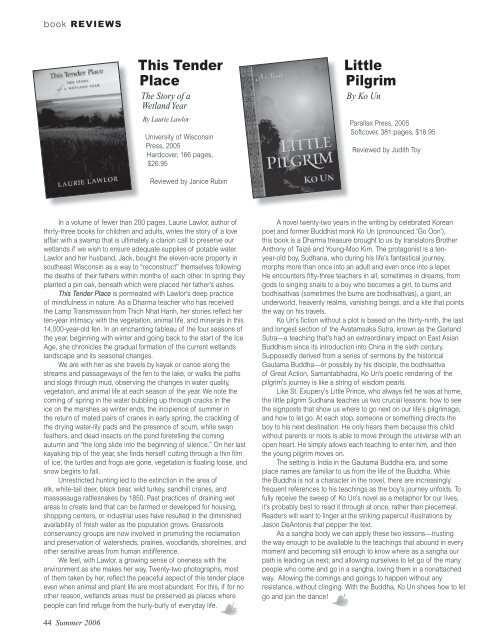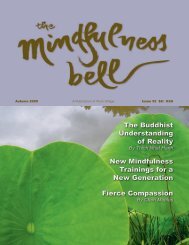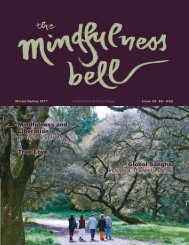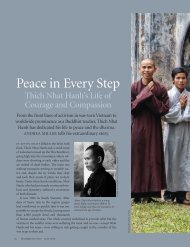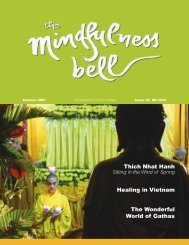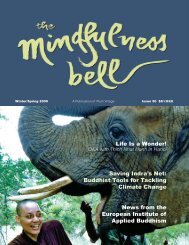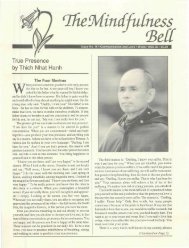Thich Nhat Hanh Jewish Roots The Better Way to Live Alone in the ...
Thich Nhat Hanh Jewish Roots The Better Way to Live Alone in the ...
Thich Nhat Hanh Jewish Roots The Better Way to Live Alone in the ...
- No tags were found...
You also want an ePaper? Increase the reach of your titles
YUMPU automatically turns print PDFs into web optimized ePapers that Google loves.
ook REVIEWSThis TenderPlace<strong>The</strong> S<strong>to</strong>ry of aWetland YearBy Laurie LawlorUniversity of Wiscons<strong>in</strong>Press, 2005Hardcover, 166 pages,$26.95LittlePilgrimBy Ko UnParallax Press, 2005Softcover, 381 pages, $18.95Reviewed by Judith ToyReviewed by Janice Rub<strong>in</strong>In a volume of fewer than 200 pages, Laurie Lawlor, author ofthirty-three books for children and adults, writes <strong>the</strong> s<strong>to</strong>ry of a loveaffair with a swamp that is ultimately a clarion call <strong>to</strong> preserve ourwetlands if we wish <strong>to</strong> ensure adequate supplies of potable water.Lawlor and her husband, Jack, bought <strong>the</strong> eleven-acre property <strong>in</strong>sou<strong>the</strong>ast Wiscons<strong>in</strong> as a way <strong>to</strong> “reconstruct” <strong>the</strong>mselves follow<strong>in</strong>g<strong>the</strong> deaths of <strong>the</strong>ir fa<strong>the</strong>rs with<strong>in</strong> months of each o<strong>the</strong>r. In spr<strong>in</strong>g <strong>the</strong>yplanted a p<strong>in</strong> oak, beneath which were placed her fa<strong>the</strong>r’s ashes.This Tender Place is permeated with Lawlor’s deep practiceof m<strong>in</strong>dfulness <strong>in</strong> nature. As a Dharma teacher who has received<strong>the</strong> Lamp Transmission from <strong>Thich</strong> <strong>Nhat</strong> <strong>Hanh</strong>, her s<strong>to</strong>ries reflect herten-year <strong>in</strong>timacy with <strong>the</strong> vegetation, animal life, and m<strong>in</strong>erals <strong>in</strong> this14,000-year-old fen. In an enchant<strong>in</strong>g tableau of <strong>the</strong> four seasons of<strong>the</strong> year, beg<strong>in</strong>n<strong>in</strong>g with w<strong>in</strong>ter and go<strong>in</strong>g back <strong>to</strong> <strong>the</strong> start of <strong>the</strong> IceAge, she chronicles <strong>the</strong> gradual formation of <strong>the</strong> current wetlandslandscape and its seasonal changes.We are with her as she travels by kayak or canoe along <strong>the</strong>streams and passageways of <strong>the</strong> fen <strong>to</strong> <strong>the</strong> lake, or walks <strong>the</strong> pathsand slogs through mud, observ<strong>in</strong>g <strong>the</strong> changes <strong>in</strong> water quality,vegetation, and animal life at each season of <strong>the</strong> year. We note <strong>the</strong>com<strong>in</strong>g of spr<strong>in</strong>g <strong>in</strong> <strong>the</strong> water bubbl<strong>in</strong>g up through cracks <strong>in</strong> <strong>the</strong>ice on <strong>the</strong> marshes as w<strong>in</strong>ter ends, <strong>the</strong> <strong>in</strong>cipience of summer <strong>in</strong><strong>the</strong> return of mated pairs of cranes <strong>in</strong> early spr<strong>in</strong>g, <strong>the</strong> crackl<strong>in</strong>g of<strong>the</strong> dry<strong>in</strong>g water-lily pads and <strong>the</strong> presence of scum, white swanfea<strong>the</strong>rs, and dead <strong>in</strong>sects on <strong>the</strong> pond foretell<strong>in</strong>g <strong>the</strong> com<strong>in</strong>gautumn and “<strong>the</strong> long slide <strong>in</strong><strong>to</strong> <strong>the</strong> beg<strong>in</strong>n<strong>in</strong>g of silence.” On her lastkayak<strong>in</strong>g trip of <strong>the</strong> year, she f<strong>in</strong>ds herself cutt<strong>in</strong>g through a th<strong>in</strong> filmof ice; <strong>the</strong> turtles and frogs are gone, vegetation is float<strong>in</strong>g loose, andsnow beg<strong>in</strong>s <strong>to</strong> fall.Unrestricted hunt<strong>in</strong>g led <strong>to</strong> <strong>the</strong> ext<strong>in</strong>ction <strong>in</strong> <strong>the</strong> area ofelk, white-tail deer, black bear, wild turkey, sandhill cranes, andmassasauga rattlesnakes by 1850. Past practices of dra<strong>in</strong><strong>in</strong>g wetareas <strong>to</strong> create land that can be farmed or developed for hous<strong>in</strong>g,shopp<strong>in</strong>g centers, or <strong>in</strong>dustrial uses have resulted <strong>in</strong> <strong>the</strong> dim<strong>in</strong>ishedavailability of fresh water as <strong>the</strong> population grows. Grassrootsconservancy groups are now <strong>in</strong>volved <strong>in</strong> promot<strong>in</strong>g <strong>the</strong> reclamationand preservation of watersheds, prairies, woodlands, shorel<strong>in</strong>es, ando<strong>the</strong>r sensitive areas from human <strong>in</strong>difference.We feel, with Lawlor, a grow<strong>in</strong>g sense of oneness with <strong>the</strong>environment as she makes her way. Twenty-two pho<strong>to</strong>graphs, mos<strong>to</strong>f <strong>the</strong>m taken by her, reflect <strong>the</strong> peaceful aspect of this tender placeeven when animal and plant life are most abundant. For this, if for noo<strong>the</strong>r reason, wetlands areas must be preserved as places wherepeople can f<strong>in</strong>d refuge from <strong>the</strong> hurly-burly of everyday life.A novel twenty-two years <strong>in</strong> <strong>the</strong> writ<strong>in</strong>g by celebrated Koreanpoet and former Buddhist monk Ko Un (pronounced ‘Go Oon’),this book is a Dharma treasure brought <strong>to</strong> us by transla<strong>to</strong>rs Bro<strong>the</strong>rAnthony of Taizé and Young-Moo Kim. <strong>The</strong> protagonist is a tenyear-oldboy, Sudhana, who dur<strong>in</strong>g his life’s fantastical journey,morphs more than once <strong>in</strong><strong>to</strong> an adult and even once <strong>in</strong><strong>to</strong> a leper.He encounters fifty-three teachers <strong>in</strong> all, sometimes <strong>in</strong> dreams, fromgods <strong>to</strong> s<strong>in</strong>g<strong>in</strong>g snails <strong>to</strong> a boy who becomes a girl, <strong>to</strong> bums andbodhisattvas (sometimes <strong>the</strong> bums are bodhisattvas), a giant, anunderworld, heavenly realms, vanish<strong>in</strong>g be<strong>in</strong>gs, and a kite that po<strong>in</strong>ts<strong>the</strong> way on his travels.Ko Un’s fiction without a plot is based on <strong>the</strong> thirty-n<strong>in</strong>th, <strong>the</strong> lastand longest section of <strong>the</strong> Avatamsaka Sutra, known as <strong>the</strong> GarlandSutra––a teach<strong>in</strong>g that’s had an extraord<strong>in</strong>ary impact on East AsianBuddhism s<strong>in</strong>ce its <strong>in</strong>troduction <strong>in</strong><strong>to</strong> Ch<strong>in</strong>a <strong>in</strong> <strong>the</strong> sixth century.Supposedly derived from a series of sermons by <strong>the</strong> his<strong>to</strong>ricalGautama Buddha––or possibly by his disciple, <strong>the</strong> bodhisattvaof Great Action, Samantabhadra, Ko Un’s poetic render<strong>in</strong>g of <strong>the</strong>pilgrim’s journey is like a str<strong>in</strong>g of wisdom pearls.Like St. Exupery’s Little Pr<strong>in</strong>ce, who always felt he was at home,<strong>the</strong> little pilgrim Sudhana teaches us two crucial lessons: how <strong>to</strong> see<strong>the</strong> signposts that show us where <strong>to</strong> go next on our life’s pilgrimage;and how <strong>to</strong> let go. At each s<strong>to</strong>p, someone or someth<strong>in</strong>g directs <strong>the</strong>boy <strong>to</strong> his next dest<strong>in</strong>ation. He only hears <strong>the</strong>m because this childwithout parents or roots is able <strong>to</strong> move through <strong>the</strong> universe with anopen heart. He simply allows each teach<strong>in</strong>g <strong>to</strong> enter him, and <strong>the</strong>n<strong>the</strong> young pilgrim moves on.<strong>The</strong> sett<strong>in</strong>g is India <strong>in</strong> <strong>the</strong> Gautama Buddha era, and someplace names are familiar <strong>to</strong> us from <strong>the</strong> life of <strong>the</strong> Buddha. While<strong>the</strong> Buddha is not a character <strong>in</strong> <strong>the</strong> novel, <strong>the</strong>re are <strong>in</strong>creas<strong>in</strong>glyfrequent references <strong>to</strong> his teach<strong>in</strong>gs as <strong>the</strong> boy’s journey unfolds. Tofully receive <strong>the</strong> sweep of Ko Un’s novel as a metaphor for our lives,it’s probably best <strong>to</strong> read it through at once, ra<strong>the</strong>r than piecemeal.Readers will want <strong>to</strong> l<strong>in</strong>ger at <strong>the</strong> strik<strong>in</strong>g papercut illustrations byJason DeAn<strong>to</strong>nis that pepper <strong>the</strong> text.As a sangha body we can apply <strong>the</strong>se two lessons––trust<strong>in</strong>g<strong>the</strong> way enough <strong>to</strong> be available <strong>to</strong> <strong>the</strong> teach<strong>in</strong>gs that abound <strong>in</strong> everymoment and becom<strong>in</strong>g still enough <strong>to</strong> know where as a sangha ourpath is lead<strong>in</strong>g us next; and allow<strong>in</strong>g ourselves <strong>to</strong> let go of <strong>the</strong> manypeople who come and go <strong>in</strong> a sangha, lov<strong>in</strong>g <strong>the</strong>m <strong>in</strong> a nonattachedway. Allow<strong>in</strong>g <strong>the</strong> com<strong>in</strong>gs and go<strong>in</strong>gs <strong>to</strong> happen without anyresistance, without cl<strong>in</strong>g<strong>in</strong>g. With <strong>the</strong> Buddha, Ko Un shows how <strong>to</strong> letgo and jo<strong>in</strong> <strong>the</strong> dance!44 Summer 2006


